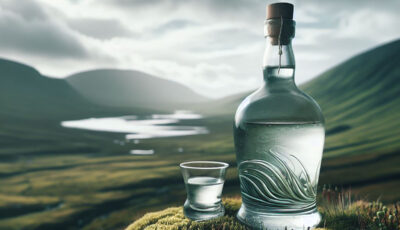Poteen (also known as poitín or moonshine) is a traditional Irish spirit… and is considered to be one of the oldest spirits in the world! Dating back to the 6th century, it stands alone as a symbol of ancient Irish Gaelic culture… but was long abused by British bans. Considered contraband alcohol as early as the 7th century, due to an English law, it was suppressed for a long time, before regaining its letters of nobility today.
A look back at this traditional Irish spirit, distilled from potatoes or malted barley.

Du Poitín – Go to Ireland.com
In Ireland, Poteen (pronounced “potcheen”) is a story of tradition and know-how going back centuries. It is thought to have been produced from the earliest days of distilling in Ireland (around 584 AD).
In those days, alcohol was expensive (especially whiskey), and it was easier for families to produce it themselves. To do so, they called on a resource they grew themselves: potatoes or malted barley, agricultural resources easily produced on the Emerald Isle.
As soon as distillation took off in Ireland, many Irish families decided to equip themselves with a still and produce their own poitín.
It was made from a small still (called a “pot still”), which was placed on the fire for double distillation. After filtration and the addition of secret ingredients, Poteen was ready to be tasted, consumed and enjoyed.
Rather strong in flavor, often very high in alcohol, poitín was drunk in a closed environment. It was rarely sold, and was mostly consumed among family members on special occasions (births, weddings, deaths, etc.). It was also available to friends and neighbors, but on a restricted basis.
In those days, every family had its own recipe… And there were as many poteen variants as there were Irish households! Some families were also known for distilling excellent recipes… It’s enough to forge a reputation in the region!
Over the centuries, moonshine has become a veritable symbol of Irish and Gaelic culture. It symbolized Irish craftsmanship and the conviviality of its inhabitants, and thus encouraged socialization.
It was only later, in 1661, that Poteen was officially declared illegal by the London government. At the time, Ireland was under English rule… And the English were multiplying their strategies to suppress Irish anger, and encourage their submission.
With this in mind, they passed the Illicit Distillation Act of 1661, a law prohibiting Irish and British families from privately producing any form of alcohol. This decision provoked an outcry and a storm of protest from the Irish people.
Surprisingly, this ban considerably boosted underground poitín production. The Irish developed vast smuggling networks all over the country to better circulate this alcohol…
For many Irish people, the ban on poteen was yet another declaration of war by the English. And a handful of inhabitants, living on the island of Inishmurray off the coast of Sligo, decided to protest in an unprecedented way…
So they proclaimed the independence of their island, and named it the “Urris Republic of Poitín”. This is how the island of Inishmurray became the last official bastion of Poitín at the time!
They took advantage of this to produce beverages in large quantities, while protecting the island from the English. To achieve this, they closed Mamore Gap, the only possible access to the island!
For three years, this autonomous micro-state, cut off from the rest of the world, lived off fishing and farming.
The British then re-established their hold on the region. Arrests were made, stills confiscated… And so ended this tumultuous period.
Although poitín remained illegal for three centuries, its ban was finally lifted by the Irish Office of the Revenue Commissioners in 1997.
At that time, only 2 official brands were authorized:
Since then, production has become much more democratic in Ireland. Other brands have joined the ranks, and poteen is enjoying a new-found popularity with consumers. It should be noted, however, that poitín production is still reserved for Ireland.
If you’re ever tempted to try this typically Irish beverage, the first thing to remember is that it’s a rustic, full-bodied spirit. Forget it if you don’t like heavy drinks!
For the average titration is generally between 40% and 90% alcohol by volume (ABV), although some can be even stronger, sometimes reaching up to 95% ABV.
The potency of this traditional Irish drink can vary according to the distillation method and ingredients used.
On the taste side, there’s very little sugar, as well as pronounced notes of alcohol and sometimes a robust flavor of cereals or potatoes, which are the traditional basic ingredients.
Due to its high alcohol content, it can also have a burning or hot character on the palate.
Some producers add additional ingredients (such as herbs) to give it more complex aromas and flavors, but overall, this drink is appreciated for its strength and rawness.
Be careful, however, if you want to discover this alcohol: you only need a tiny glass to feel its effects. Drink in moderation.
Increasingly fashionable, moonshine has seen many distillers emerge over the years. Many Irish whiskey distilleries (such as Teeling Distillery and Micil Distillery) have also taken up the poitín, and are vying with each other to raise their spirits to the level of the genre’s best competitors.
They all try to set themselves apart by personalizing their recipes, using premium ingredients and combining ancestral techniques with more modern processes.
A practice that has considerably enriched the market for this artisanal beverage! Here’s a look at some of today’s influential brands:
Prices vary from €20 to €50, depending on quality and distillery. Note that some Irish pubs offer them. You’ll also find them in supermarkets, but their prices are often higher than if you buy them imported…
Alcohol abuse is dangerous for your health. Drink in moderation.